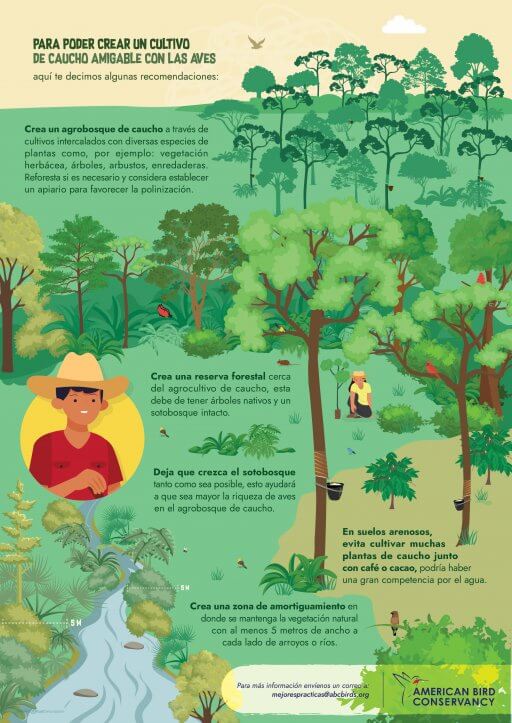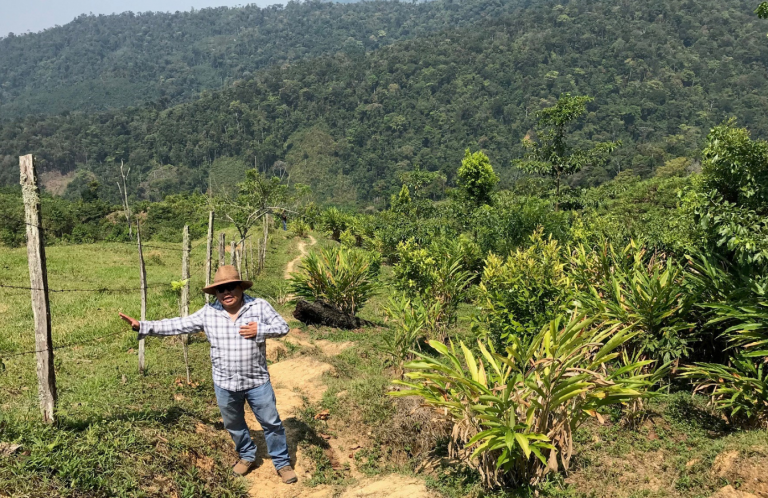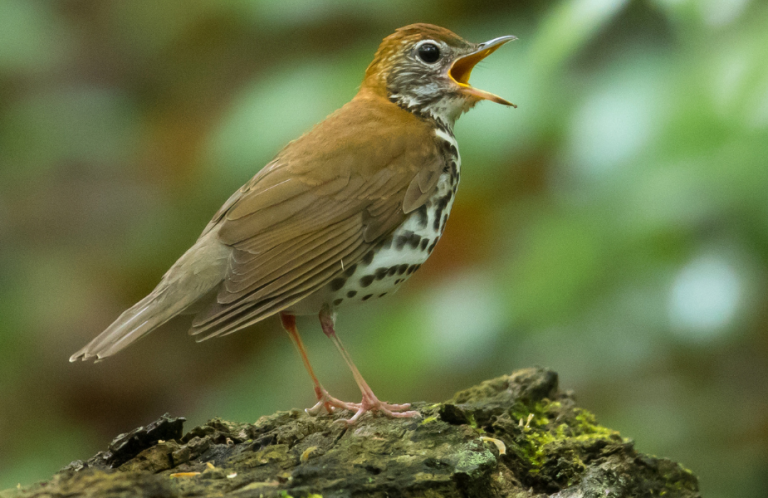Conservation at the Scale Needed: Helping Migratory Birds Bounce Back on Natural Rubber Plantations

Rubber trees — more precisely, the sticky sap that comes from them — are the building blocks of everything from tennis balls to tires. That sappy substance called latex is tapped from the Hevea brasiliensis tree, much like maple syrup! A rubber plantation may not be the first thing that springs to mind when it comes to high-quality bird habitat. However, a 2018 study supported by American Bird Conservancy (ABC) showed when rubber tree plantations are managed sustainably, they can contribute meaningfully to bird conservation and go the extra mile for birds. Since 2022, ABC has been working with local partner Hevea Costa Rica (Hevea) to expand and connect critical bird habitats in Costa Rica by creating natural rubber plantations, which traditionally use degraded lands, and provide a sustainable alternative to other methods of growing rubber trees that often rely on deforestation.
Now, that partnership is getting a boost with the support of Michelin, one of the largest tire producers in the world. The company has indicated its willingness to provide technical support to ensure the project's success in Costa Rica. As a member of the Global Platform for Sustainable Natural Rubber (GPSNR), Michelin's involvement is much more than a rubber stamp: Michelin has also positioned itself as a potential buyer for natural rubber that meets their rigorous sustainability standards and technical specifications produced on these bird-friendly plantations.
“Through our work with Hevea Costa Rica, American Bird Conservancy is helping to convert thousands of acres of degraded pasturelands to thriving, working habitat that supports both birds and people, and we are thrilled to have Michelin's support in this effort,” said Andrés Anchondo, ABC's Director of Migratory Bird Habitats in Latin America and the Caribbean. “It is our hope that we can grow this project and create more quality habitat for birds, promote best practices for sustainable agriculture, and open more economic opportunities for Indigenous people and local communities in Costa Rica and throughout Latin America.”

The lush Costa Rican lowlands signal a sweet spot to land for Neotropical migratory birds. Of the 220 migratory birds found in the country, 180 use the Caribbean slope's wet tropical forests as stopover habitat during migration or for an extended stay in the non-breeding season. Decades of deforestation, overgrazing of cattle, and large-scale production of monoculture crops like pineapples and bananas have left the habitat fragmented and degraded. These conditions are challenging for wildlife and people who make their living on the land. This habitat loss, whether through deforestation or degradation, is the primary driver of population declines for the Golden-winged Warbler, Wood Thrush, Kentucky Warbler, and the Endangered Great Green Macaw.
Here's where the rubber meets the road: high-quality bird habitat can be created or enhanced by managing natural rubber plantations. And, it can be done in a way that balances sustainability, the well-being and livelihoods of local communities, and industry needs.
Natural rubber plantations of Hevea brasiliensis trees, a plant native to the Amazon basin, can be valuable bird habitat. The addition of other native hardwood tree species and an agroforestry approach can make that habitat richer and support more birds in terms of both abundance and diversity. Adding a mix of hardwoods, retaining towering legacy trees that reach heights of over 40 meters, and managing the understory make a rubber plantation all the more inviting for birds.
The effort to create bird-friendly rubber plantations is part of a larger plan to help migratory birds bounce back from the steep population declines many species have experienced in the last several decades. The area where Hevea's work takes place is part of the Costa Rica Lowlands BirdScape. ABC's BirdScapes approach recognizes that a migratory bird's habitat changes throughout its full annual cycle and prioritizes the most critical habitats birds use throughout the year, from breeding grounds in North America to non-breeding grounds in Latin America and the Caribbean and the stopover habitats in between.
Hevea Costa Rica was founded in 2015 with the objective of converting the country's degraded and overgrazed agricultural lands to sustainable natural rubber plantations, which would not only be free from deforestation but would actually help with reforestation efforts. Traditional rubber production is land-intensive and often requires clearing forested areas where dozens of resident and migratory bird species would otherwise live. Sustainably produced rubber proves that the production process doesn't have to put a squeeze on wildlife. When done right, sustainable natural rubber production can add to the land, creating high-quality habitat and enhancing biodiversity.
Hevea is working with ABC's BirdsPlus program, an initiative to support ranchers and farmers in Latin America and the Caribbean in adopting best management practices that make their land work for them — and for birds. Farmers can connect to finance and market opportunities to scale up their habitat management practices. Given the dramatic losses of migratory bird populations, ABC is acting boldly to achieve conservation at the scale and urgency needed to restore migratory bird habitat. BirdsPlus provides a unique opportunity for a win-win collaboration between nature and people.
Supporting these collaborations also means building networks that put conservationists in touch with the supply chain. ABC partner BirdLife International, a founding member of the GPSNR, helped facilitate the connection that brought the partnership with Michelin to fruition.
“BirdLife understands that if we are to effectively conserve species and habitats, we need to ensure that the goods demanded by society can be supplied sustainably,” said Sue Mulhall, Head of Biodiversity and Business Engagement, BirdLife International. “The GPSNR brings together companies, smallholders, academia, and civil society to transform the natural rubber supply chain into a sustainable, equitable, and fair one.”
Hevea is also building a “pipeline” of native hardwood and rubber tree seedlings. Eventually, those seedlings will become new bird habitat across 37,000 acres of restored pasture. For this, Hevea is seeking investments from impact investors looking to turn a profit and conserve migratory birds. The road to making rubber work for birds isn't finished, not by any stretch of the imagination.
Check out a webinar to learn more about ABC's BirdsPlus program, the BirdsPlus Index for measuring biodiversity, and the BirdsPlus Fund for scaling up agroforestry projects to support local communities. Help migratory birds bounce back wherever you are — no rubber trees needed — by adopting a bird-friendly lifestyle, using native plants in your garden, and drinking bird-friendly coffee produced in the regions where many migratory birds spend the non-breeding season.
###
American Bird Conservancy (ABC) takes bold action to conserve wild birds and their habitats throughout the Americas. Inspired by the wonder of birds, we achieve lasting results for the bird species most in need while also benefiting human communities, biodiversity, and the planet's fragile climate. Our every action is underpinned by science, strengthened by partnerships, and rooted in the belief that diverse perspectives yield stronger results. Founded as a nonprofit organization in 1994, ABC remains committed to safeguarding birds for generations to come. Join us! Together, we can do more to ensure birds thrive.
Media Contact
Jordan Rutter
Director of Communications
media@abcbirds.org




















































